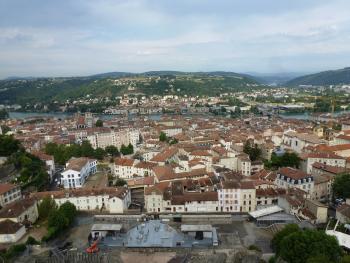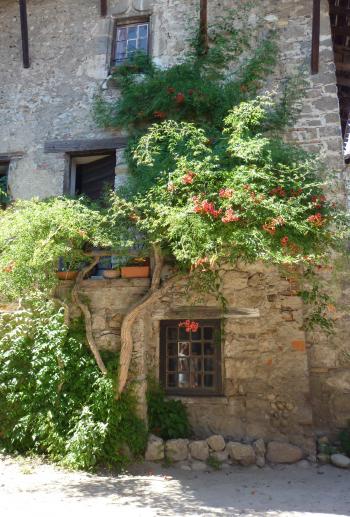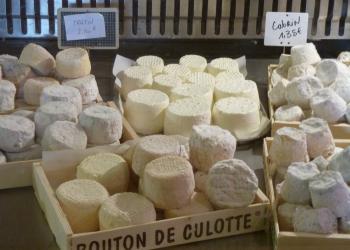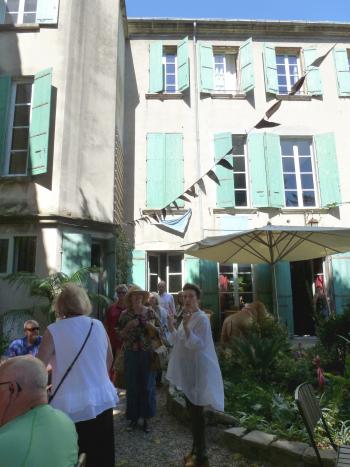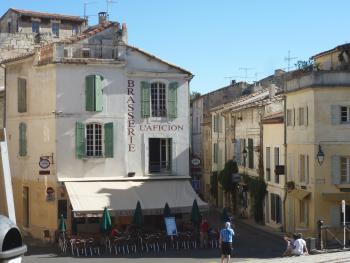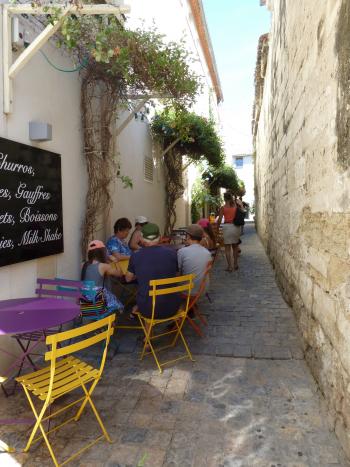Food and fun in France: Cruising from Lyon to Avignon
This article appears on page 6 of the November 2016 issue.
My earliest memory is connected to food. I can still feel the anticipation, waiting for my turn to shake the Mason jar filled with cream that was making its way around my kindergarten class and watching as a pale-yellow form began to emerge through the opaque liquid. Butter on a graham cracker never tasted so good!
So it’s no wonder that my strongest memories of the travels I’ve taken over the years would be of the tastes I’ve experienced, whether extraordinarily enjoyable or please-don’t-make-me-take-another-bite bad. My greatest connection to a culture seems to be through its cuisine.
My most recent trip, a July-August 2016 river cruise through France’s Provence region, featured Roman ruins, cobblestone-lined villages and fields filled with flowers — landscapes that have inspired many an artist — but when I think back on the moments I enjoyed the most, well, you can guess where this is heading.
First impressions
A family wedding led me to Europe this summer, so I decided to try to make the most of my time there. I was fortunate to end my European vacation as the guest of Viking River Cruises on their 8-day “Lyon & Provence” journey aboard the Viking Heimdal, one of Viking’s 190-passenger longships.
The moment my sister, Cindy, with whom I was traveling, and I stepped on board the bright, beautifully designed ship, we were warmly welcomed. From the reception staff (who knew us by name before the first day had ended) to the cleaning crew, everyone had a smile to offer and a friendly “Hello.”
Our itinerary began in Lyon, where the Rhône and Saône rivers meet, and we were to continue the next day to the town of Mâcon, in the center of the Beaujolais region. However, heavy rains, which, thankfully, had ceased just a few days before our embarkation, had caused the Saône to swell, making it impossible for our ship to pass under the bridges that crossed the river.
Remaining docked in Lyon, we traveled by bus to our first included excursion, a wine tasting and a tour of Château des Ravatys, bequeathed to the Pasteur Institute of Paris in 1937. (Profits from the estate are given back to the institute to support public health research.)
There, I was impressed not only by the deep-ruby Brouilly and Côte de Brouilly wines we tasted but by the handling of the large number of passengers touring the relatively small property. At the dock, participants were assigned to a number of different buses in groups of about 15 or so, and, after arriving at the château, each group toured a different area of the property, thus avoiding the feeling of being “herded” around the site.
Also, as on all of the excursions we would take, individual audio devices ensured that everyone could hear their guide’s presentation.
Savory samplings
To follow the wine, it was time for some cheese, as our touring day continued with an optional excursion to a goat cheese farm and a truffle orchard ($79 per person). While the other optional excursion, a visit to the Abbey of Cluny, sounded interesting, the culinary choice, of course, won out for me.
It was a pleasant afternoon spent sampling creamy, fresh chèvre and a more complexly flavored aged variety after having had a chance to “visit” with the goats whose milk had produced them. (As the cheeses are made from raw milk, any samples purchased at the on-site shop have to be eaten before flying home, but I did buy several jars of the most delicious goat-milk caramel sauce as a souvenir.)
We finished the day with an explanation of how a truffle grove is planted plus a demonstration of the talents of Chinook, the truffle-sniffing dog. We then were treated to a taste of this highly prized (and incredibly expensive) fungus before heading back to the ship.
Our third, and final, day docked in Lyon began with an included city tour, the only tour in which I was disappointed, as the sites visited were incredibly crowded with passengers from a number of other ships that had arrived in the city that day. I think some independent exploration, away from the typical tourist stops, might have been a more enjoyable way to discover the city. What saved the day, however, was the optional excursion to Pérouges ($59 per person) that afternoon!
This medieval village was achingly charming, its hilly streets paved with smooth river rocks (good walking shoes are a must) and lined with a profusion of brightly colored flowers spilling from the window boxes of the centuries-old stone houses.
While this feast for the eyes would have been enough for me to mark this as a highly recommended tour, our taste buds were also given a treat, as our local guide secured samples of the area’s traditional sweet galette, a thin, pizza-like dough topped with butter, sugar and a bit of citrus zest and baked to crispy-chewy perfection.
A sweet surprise
Our ship continued on to Vienne, home to a treasure trove of Roman ruins, before sailing on toward Tournon. It was there that my sister and I decided to take a little break from the scheduled touring.
Because it was a Sunday, the shops and other sites of interest were closed, but Program Director Nikolas Rabogliatti, who was full of helpful information and readily shared his witty sense of humor with everyone on board, pointed us in the direction of the one place that was open: La Cité du Chocolat (12 Avenue du Président Roosevelt, Tain l’Hermitage; citeduchocolat.com).
Could it be? A city of chocolate? Actually, La Cité du Chocolat is Valrhona’s Discovery Center, where exhibits inform visitors about the process of making chocolate and about the history of the company. It was like Willy Wonka’s chocolate factory for the refined palate!
But the best part? The exhibits didn’t feature just photos, text or videos. Almost everywhere I turned, there was a sample of chocolate waiting to be devoured!
Yes, this was a clever marketing tool to encourage patrons to head on over to the on-site shop (and it worked, as I spent more than €50, or $56, on edible gifts for friends and family). But that didn’t make the chocolate any less enjoyable. This stop was well worth the €9 price of admission. The shop also threw in a number of free samples to go.
A most memorable day
The next day we arrived in Avignon, and it was time for the excursion I had been waiting for. While the optional offerings for the day included a number of enticing choices — a visit to Châteauneuf-du-Pape and a lavender tour among them — Cindy and I decided on the half-day “Taste of Provence” ($199 per person).
Luckily, we had booked this, like all of our chosen optional excursions, before leaving home, as it was sold out by the time we arrived on board. At www.myvikingjourney.com, travelers scheduled on a Viking cruise can book their excursions ahead of time and also find detailed information and independent touring suggestions for the stops on their itinerary.
This day would prove to be the one I recall first when thinking back on this trip. It was my favorite day, but this was not the case, I would later find out, for everyone who participated.
Our 9:30 a.m. departure began with a disappointing announcement: because it was Monday, we would not be visiting Avignon’s covered market, Les Halles, which is open Tuesday through Sunday only.
To be fair, while I seem to recall the market visit being mentioned in the online description of this excursion, it actually was not mentioned in the detailed description printed in the cruise documents I received well before departure. But perhaps the fact that the market would not be included should have been noted, rather than its mention just omitted, to avoid disappointing tour members.
To fill the time before lunch, our guide led us through the winding streets of Avignon, with stops at La Cure Gourmande, to sample their baked confections, and Les Delices du Luberon, to taste tapenades and olive oils, but the day truly began for me when we stopped outside a rather nondescript wooden door with a simple brass plaque that read “Maison de Fogasses” (37 rue des Fourbisseurs; www.maison-de-fogasses.com).
Our knock on the door was answered by Corinne, the owner of this grand, 15th-century townhouse. As we were welcomed inside, it was like walking through a portal into another world, a whimsical world of eclectically designed rooms that led to a garden that I could have happily spent days enjoying.
A long table beneath banners of brightly colored flags awaited our group of 18, and, with wine made by a friend of hers, Corinne welcomed each of us to her home, a part-time retreat for artists and musicians that also acts as a restaurant and a cooking school and offers five vacation apartments for travelers. (Apartments cost from €99 to €140 per night and require a minimum 2-night stay.)
Part of this day was to feature a cooking lesson, but with such a large group, we were split into two, one group heading upstairs to learn how to make fougasse, a savory Provençal flatbread, along with cream puffs minus the cream. The other group waited out their turn in the garden playing pétanque, similar to the Italian game of bocce, switching with the first group before our 4-course lunch was served.
We began with the fougasse we had made and ended with a chocolate dessert, our “puffs” having been carefully packed in individual bags for us to take back to the ship.
I found the entire experience delightful (with the exception, perhaps, of the heat in the kitchen on that warm summer day). The staff was incredibly engaging, and the energy of the place seemed, to me, joyful. So imagine our surprise when Cindy and I returned to the ship, after separating from the group to do a bit of shopping on the walk back, and discovered that many had complained about the day, some even asking for their money back.
I’m still confounded, but it was a clear illustration of why we print in ITN the varying opinions of our readers. Each person’s experience is filtered through his or her own expectations and emotions. I can only share my personal viewpoint, and, for me, it was the highlight of the cruise.
To the delta
Our cruise was nearing its close as we made a last stop, in Arles, before returning to Avignon, where we would disembark. Again, there were several optional excursions to choose from, in addition to the included city walking tour, and we decided to travel a bit beyond the city to explore the Camargue ($149 per person), the protected Rhône River Delta region.
We began with a brief tour of Arles, the city that inspired van Gogh’s most prolific period, before heading to a ranch where Camargue cattle are bred in the hopes that a prize fighter might make an appearance in the ancient Roman arena in Arles.
Bullfighting in this region is unlike that in Spain. The object of the fight is for the matador, or raseteur, to pluck a tassel from between the bull’s horns. The animal is not killed but, rather, is celebrated and can go on to have a long career. (As our guide said, “If there is blood in the ring, it is not the bull’s.”)
Along the way, we passed the iconic white Camargue horses, used to herd the cattle, and saw myriad bird species, including flamingos, that call this area their home. We enjoyed a delicious multicourse meal before heading out for a tractor ride to see the bulls up close.
Our final stop for the day was the medieval town of Aigues-Mortes, a town painted in cheerful hues that sent my quaint-o-meter to its highest mark!
Life on board
Our week-long journey was a lovely introduction to this beautiful region of France, and sailing aboard the Viking Heimdal was a wonderful way to travel.
The ship had an intimate feel, and the open seating in the dining room and the smaller-group excursions allowed us to meet many interesting travelers and make some new friends.
We ate most of our meals in the ship’s main dining room, which offered a delicious selection of 3-course dinners each evening, always including one vegetarian choice, with both buffet and made-to-order options for breakfast and lunch.
With a more limited menu but offering a nice alternative to the sometimes-noisy space of the full dining room, the glass-lined Aquavit Terrace featured tables inside and out, taking advantage of the river views.
Wine was included with lunch and dinner, most often from wineries in and around the area visited that day.
Our third-floor veranda stateroom ($4,299 per person, though Viking often runs special discounts) was on the same level as the lounge, which was convenient for attending the evening briefings of the next day’s activities.
There is elevator access between the middle deck, where the dining room and reception are located, and the upper floor, but, for those with mobility issues, it’s worth noting that it does not travel to the cabins on the lower deck.
Having our own veranda was fabulous on the few days we sailed during the day, but in the busy summer season, when we were docked we often had other ships docked immediately next to ours, making the outdoor space not all that useful for a good portion of the time (though the extra cabin space that came with this cabin category was definitely a plus).
Unlike on large ocean cruise ships, the onboard entertainment was limited (though enjoyable). However, there was so much to do, between touring, meals, briefings and special offerings from the crew — like French lessons from the program director and a cooking demonstration given by the executive chef — that each day flew by.
As this was only the second river cruise I’d ever taken (and my first with Viking), I can’t fairly compare the service with that of other cruise lines, but I can say that the unfailingly friendly (but not fake) demeanor of every member of the staff and their efforts to make each day an enjoyable one for all on board are among the reasons I would return.
For more information on this or any of the other river cruise itineraries offered in Europe and Asia, contact Viking River Cruises (Woodland Hills, CA; phone 800/632-0245, www.vikingrivercruises.com).

